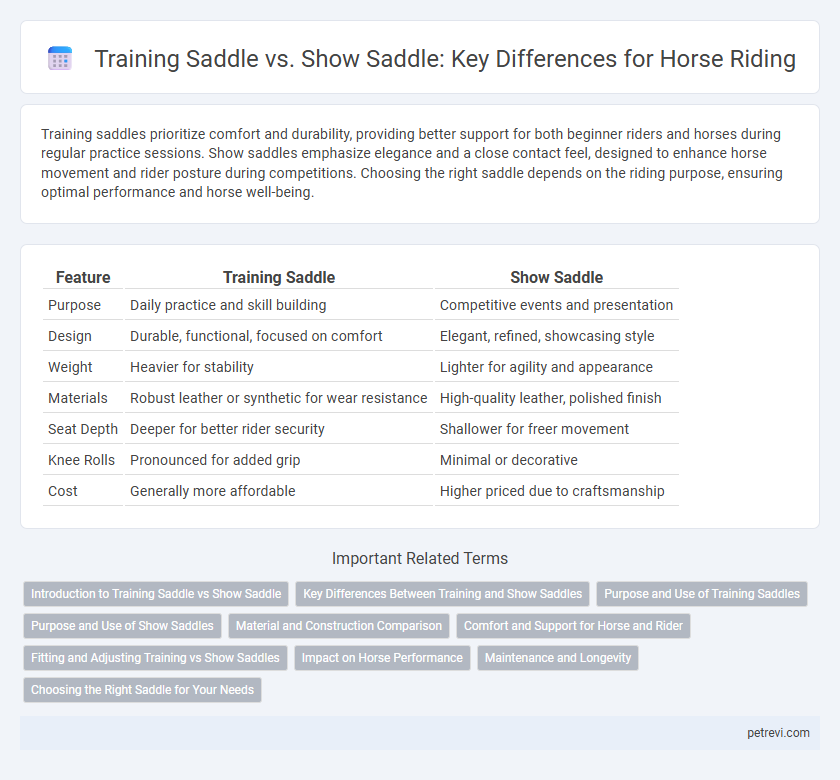Training saddles prioritize comfort and durability, providing better support for both beginner riders and horses during regular practice sessions. Show saddles emphasize elegance and a close contact feel, designed to enhance horse movement and rider posture during competitions. Choosing the right saddle depends on the riding purpose, ensuring optimal performance and horse well-being.
Table of Comparison
| Feature | Training Saddle | Show Saddle |
|---|---|---|
| Purpose | Daily practice and skill building | Competitive events and presentation |
| Design | Durable, functional, focused on comfort | Elegant, refined, showcasing style |
| Weight | Heavier for stability | Lighter for agility and appearance |
| Materials | Robust leather or synthetic for wear resistance | High-quality leather, polished finish |
| Seat Depth | Deeper for better rider security | Shallower for freer movement |
| Knee Rolls | Pronounced for added grip | Minimal or decorative |
| Cost | Generally more affordable | Higher priced due to craftsmanship |
Introduction to Training Saddle vs Show Saddle
Training saddles feature a deeper seat and higher pommel to provide greater security and comfort during daily practice, making them ideal for building rider confidence and balance. Show saddles prioritize a flatter seat and minimal padding to promote a closer contact with the horse, enhancing precision and style in competitive dressage or jumping events. Understanding these design differences helps riders select the optimal saddle to improve performance and comfort tailored to specific riding disciplines.
Key Differences Between Training and Show Saddles
Training saddles prioritize comfort, durability, and rider stability with deeper seats and longer flaps to support extended riding sessions and varied exercises. Show saddles emphasize aesthetics and precision, featuring a flatter seat and shorter, straighter flaps to allow closer leg contact and optimal rider posture for competition presentation. Material quality and design details differ significantly, with show saddles often incorporating finer leather and decorative stitching for an elegant appearance, while training saddles focus on functionality and ease of maintenance.
Purpose and Use of Training Saddles
Training saddles are designed for daily use, offering maximum comfort and support to both horse and rider during extended riding sessions. These saddles prioritize durability and functionality, featuring deeper seats and padded panels to ensure stability and minimize fatigue on training grounds. Show saddles, in contrast, emphasize sleek design and rider posture for competition, often sacrificing some comfort for appearance and precision.
Purpose and Use of Show Saddles
Show saddles are specifically designed for horse competitions, emphasizing aesthetics and rider position to meet strict judging standards. They feature a close contact design to enhance communication between horse and rider, promoting precise movements essential in dressage or jumping events. Unlike training saddles, show saddles prioritize elegance and performance refinement, optimizing both the horse's appearance and the rider's form in the show ring.
Material and Construction Comparison
Training saddles typically use durable synthetic or lower-grade leather materials designed for comfort and long-term use during daily riding sessions, featuring a sturdier build with deeper seats and wider panels to support rider stability. Show saddles prioritize high-quality, supple leather with finely crafted details, thinner panels, and a more streamlined construction to enhance rider posture and aesthetics in competitions. The difference in material quality and saddle construction directly impacts performance, comfort, and rider appearance based on the riding discipline.
Comfort and Support for Horse and Rider
Training saddles prioritize comfort and durability with well-padded seats and wider trees to evenly distribute the rider's weight, reducing pressure points for the horse during extended riding sessions. Show saddles feature a more refined design with closer contact panels and a snugger fit, enhancing rider stability and communication with the horse while maintaining adequate support. Both saddle types aim to balance rider comfort and equine wellbeing, but training saddles emphasize long-term support, whereas show saddles focus on precision and posture for competitive performance.
Fitting and Adjusting Training vs Show Saddles
Training saddles prioritize comfort and durability with adjustable features to accommodate long riding sessions, ensuring proper fit to minimize pressure points and enhance horse movement. Show saddles emphasize precision fitting with a closer contact design, tailored panels, and fine-tuned adjustments to optimize rider balance and presentation during competitions. Proper saddle fitting and adjusting prevent discomfort, promote horse performance, and reduce the risk of injury, making these factors crucial when selecting between training and show saddles.
Impact on Horse Performance
Training saddles are designed to prioritize comfort and support for both horse and rider during extended practice sessions, promoting natural movement and reducing muscle strain. Show saddles emphasize a close-contact fit and enhanced rider position, allowing precise cues and refined communication that can improve competitive performance. The choice between training and show saddles directly influences the horse's agility, balance, and responsiveness, ultimately affecting overall performance in riding disciplines.
Maintenance and Longevity
Training saddles are designed for daily use and typically feature durable materials like synthetic leather or reinforced stitching to withstand frequent wear, facilitating easier cleaning and routine maintenance. Show saddles prioritize aesthetics and lightweight construction, often requiring meticulous care with specialized leather conditioners and regular polishing to maintain their appearance and structural integrity. Proper maintenance of either saddle type, including regular cleaning and storage in a controlled environment, significantly extends the saddle's longevity and performance during horse riding activities.
Choosing the Right Saddle for Your Needs
Training saddles prioritize comfort and durability, featuring deeper seats and thicker padding to support long hours of practice and rider stability. Show saddles emphasize sleek design and minimal bulk, allowing for enhanced movement and refined posture during competitive events. Selecting the right saddle depends on your riding goals, whether focused on daily training sessions or performance in horse shows.
Training Saddle vs Show Saddle for Horse Riding Infographic

 petrevi.com
petrevi.com